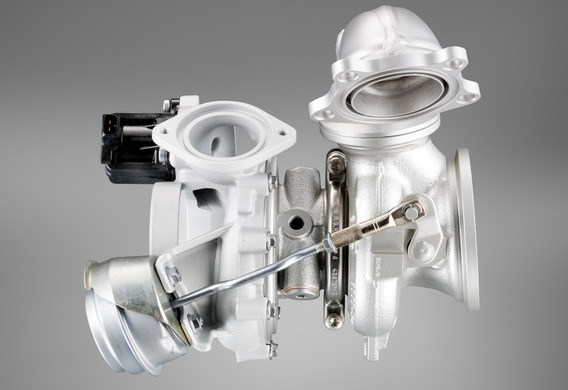
The turbocharger system, which uses two turbochargers, is Twin Turbo.
Originally, the two turbochargers were used to overcome the inertia of the system, the so-called turbobays. In the future, the scope of the turbocharger turbocharger has increased and is now able to significantly increase output capacity, maintain a nominal torque within a wide range of engine speeds and lower specific fuel consumption. There are three structural schemes of Twin Turbo: parallel, sequential and ramped. Schemes differ in the characteristics, arrangement and operation of turbochargers. The turbocharger operation regulates the electronic control system, including the input sensors, the control unit and the control valves of air and exhaust gas. Twin Turbo is the trade name of the turbocharged system, the other name used (synonym) Biturbo. In some sources, the information called Biturbo is a system with parallel turbocharger design, which is not quite true.
Twin Turbo parallel boost diagram
The parallel Twin Turbo system consists of two identical turbochargers operating simultaneously and simultaneously. Parallel work is implemented by smooth separation of exhaust flow between turbochargers. The compressed air from each compressor enters the total intake manifold and is further distributed in cylinders. Parallel Twin Turbo applies mainly to V-shaped diesel engines. Each turbocharger is fixed to its exhaust manifold. The efficiency of the parallel turbocharging scheme is based on the two small turbines have less inertia than one large. This reduces the "turboyama", the turbochars operate at all engine speeds, providing a quick boost to boost pressure. The two-stage turbocharging system of the two-stage turbocharging system consists of two turbochargers of different sizes, mounted consecutially in the exhaust (air) paths. The exhaust and intake air flow control is used in the system. The exhaust gas exhaust valve shall be closed at low engine speed. The exhaust gases pass through the small turbocharger (has minimal inertia and maximum return) and further through a large turbocharger. Exhaust gas pressure is small. So the big turbine almost doesn't revolve. The outlet pressure relief valve is closed. Air passes through the large (first step) and small (second stage) compressors. Turbocharger cooperative work is carried out with increasing turnover. The exhaust gas transfer valve shall be gradually opened. A portion of the exhaust goes directly through a large turbine, which is growing more intensely. On the intake, the large compressor compresses the air with some pressure, but it is not large enough. Therefore, compressed air is supplied to a small compressor where further pressure is increased. The boost inlet valve is still closed. The exhaust valve shall be open at full load. Gaza is almost completely through a large turbine, swinging it to its highest frequency. The small turbine stops. On the intake, the large compressor provides the maximum boost pressure. The small compressor, on the other hand, creates an air barrier, so at some point the boost valve is opened and the compressed air is directly connected to the engine. Thus, the two-stage turbocharging system ensures the efficient operation of turbocharger in all engine operating modes. The system allows known diesel engines between high low torque speed and high speed power. With the use of two-stage turbochargers, the rated torque shall be obtained fast and maintained in a wide range of engine speeds and the maximum power increase shall be ensured.







